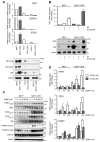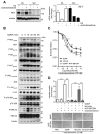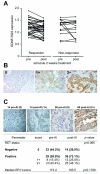GDNF-RET signaling in ER-positive breast cancers is a key determinant of response and resistance to aromatase inhibitors
- PMID: 23650283
- PMCID: PMC3686594
- DOI: 10.1158/0008-5472.CAN-12-4265
GDNF-RET signaling in ER-positive breast cancers is a key determinant of response and resistance to aromatase inhibitors
Abstract
Most breast cancers at diagnosis are estrogen receptor-positive (ER(+)) and depend on estrogen for growth and survival. Blocking estrogen biosynthesis by aromatase inhibitors has therefore become a first-line endocrine therapy for postmenopausal women with ER(+) breast cancers. Despite providing substantial improvements in patient outcome, aromatase inhibitor resistance remains a major clinical challenge. The receptor tyrosine kinase, RET, and its coreceptor, GFRα1, are upregulated in a subset of ER(+) breast cancers, and the RET ligand, glial-derived neurotrophic factor (GDNF) is upregulated by inflammatory cytokines. Here, we report the findings of a multidisciplinary strategy to address the impact of GDNF-RET signaling in the response to aromatase inhibitor treatment. In breast cancer cells in two-dimensional and three-dimensional culture, GDNF-mediated RET signaling is enhanced in a model of aromatase inhibitor resistance. Furthermore, GDNF-RET signaling promoted the survival of aromatase inhibitor-resistant cells and elicited resistance in aromatase inhibitor-sensitive cells. Both these effects were selectively reverted by the RET kinase inhibitor, NVP-BBT594. Gene expression profiling in ER(+) cancers defined a proliferation-independent GDNF response signature that prognosed poor patient outcome and, more importantly, predicted poor response to aromatase inhibitor treatment with the development of resistance. We validated these findings by showing increased RET protein expression levels in an independent cohort of aromatase inhibitor-resistant patient specimens. Together, our results establish GDNF-RET signaling as a rational therapeutic target to combat or delay the onset of aromatase inhibitor resistance in breast cancer.
©2013 AACR.
Figures






References
-
- Forbes JF, Cuzick J, Buzdar A, Howell A, Tobias JS, Baum M. Effect of anastrozole and tamoxifen as adjuvant treatment for early-stage breast cancer: 100-month analysis of the ATAC trial. Lancet Oncol. 2008;9:45–53. - PubMed
-
- Winer EP, Hudis C, Burstein HJ, Wolff AC, Pritchard KI, Ingle JN, et al. American Society of Clinical Oncology technology assessment on the use of aromatase inhibitors as adjuvant therapy for postmenopausal women with hormone receptor-positive breast cancer: status report 2004. J Clin Oncol. 2005;23:619–29. - PubMed
-
- Martin LA, Farmer I, Johnston SR, Ali S, Marshall C, Dowsett M. Enhanced estrogen receptor (ER) alpha, ERBB2, and MAPK signal transduction pathways operate during the adaptation of MCF-7 cells to long term estrogen deprivation. J Biol Chem. 2003;278:30458–68. - PubMed
-
- Martin LA, Pancholi S, Chan CM, Farmer I, Kimberley C, Dowsett M, et al. The anti-oestrogen ICI 182,780, but not tamoxifen, inhibits the growth of MCF-7 breast cancer cells refractory to long-term oestrogen deprivation through down-regulation of oestrogen receptor and IGF signalling. Endocr Relat Cancer. 2005;12:1017–36. - PubMed
Publication types
MeSH terms
Substances
Grants and funding
LinkOut - more resources
Full Text Sources
Other Literature Sources
Medical
Molecular Biology Databases

